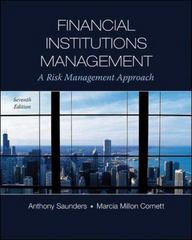Question
(a) What is the future value of a 4-year ordinary (regular) annuity of $2,750 if the appropriate interest rate is 5.6%? (b) What is the
- (a) What is the future value of a 4-year ordinary (regular) annuity of $2,750 if the appropriate interest rate is 5.6%?
(b) What is the present value of this 4-year ordinary annuity?
(c) What would the i) future, and ii) present value, be if this annuity were an annuity due (still 4 years)? Hint: set your calculator to BGN, there is a video in M2 that shows you how to do this. Dont forget to reset to END after you work an annuity due problem.
FV =
PV =
- Compare the results you got in part b for present and future value of a "regular" annuity and compare these to the values you got for the annuity due (part c). What is the relationship that you see? Using the time value of money concepts you have learned so far, why does this relationship (PV of regular annuity vs. annuity due and FV of regular annuity vs. annuity due occur? (4 points)
- What is the present value of the following uneven cash flow stream? The appropriate interest rate is 5.6%, compounded annually. Note that the final cash flow represents a project where there may be reclamation or other end of project costs which are greater than any final income and/or salvage value.
- What annual interest rate will cause $2,750 to grow to $4,200 in 5 years, assuming annual compounding? Show your answer to 2 decimals (x.xx%)
- Will the future value be larger or smaller if we compound an initial amount more often than annuallyfor example, every 6 months, or semiannually holding the stated interest rate constant? Explain your answer.
- a) What is the future value of $2,750 after six years under 5.6% semiannual compounding
9b) What is the effective annual rate for 5.6% interest with semiannual compounding? Be sure to show your EAR answer to 2 decimals, that is xx.xx%
9c) What is the future value of $2,750 after six years under 5.6% quarterly compounding?
9d) What is the effective annual rate (EAR) for 5.6% interest with quarterly compounding?
9e) Explain how the effective annual rate changes based on the number of compounding periods per year.
9f) What is the future value of $2,750 after six years under 5.6% daily compounding? Assume 365 day years and do not do any interim rounding.
9g) What is the effective annual rate for 5.6% (APR) interest with daily compounding?
- Will the effective annual rate ever be equal to the simple (quoted) rate? Explain.
- (a) Assume that you have borrowed $15,000 for 3 years and you have an annual interest rate of 5.6% (annual percentage rate or APR). What is the monthly payment due on the loan?
(b) Switch gears here and now assume that the payments are made annually. What is the annual interest expense for the borrower (this is also the annual interest income for the lender) during Year 1? (Hint: Go to the TVM lecture notes for multiple cash flows and go to slide 15.)
- You are about to buy a home; the purchase price of the car is $200,000 and you are paying 10% of that amount as a down payment and financing the remainder. Your mortgage loan terms are 30 years of monthly payments at an annual rate of 3.25%.
- How much are your monthly mortgage payments?
- Over the life of the loan, how much did you pay in interest?
- a) Suppose on January 1 you deposit $2,750 in an account that pays a quoted interest rate of 2.35% (APR), with interest added (compounded) daily. How much will you have in your account on October 1, or after 9 months? (assume N = 273 days) Recall that the interest rate (I/Y) represents the periodic rate based on how many times per YEAR the interest is compounded. Hint, this is 365 times per year. As above, and all TVM type problems, there should be no interim rounding of the interest rates.
b) Now suppose you leave your money in the bank for 21 months. Thus, on January 1 you deposit $2,750 in an account that pays an APR of 2.35% compounded daily. How much will be in your account on October 1 of the following year? (assume N = 638 days)
Step by Step Solution
There are 3 Steps involved in it
Step: 1

Get Instant Access to Expert-Tailored Solutions
See step-by-step solutions with expert insights and AI powered tools for academic success
Step: 2

Step: 3

Ace Your Homework with AI
Get the answers you need in no time with our AI-driven, step-by-step assistance
Get Started


